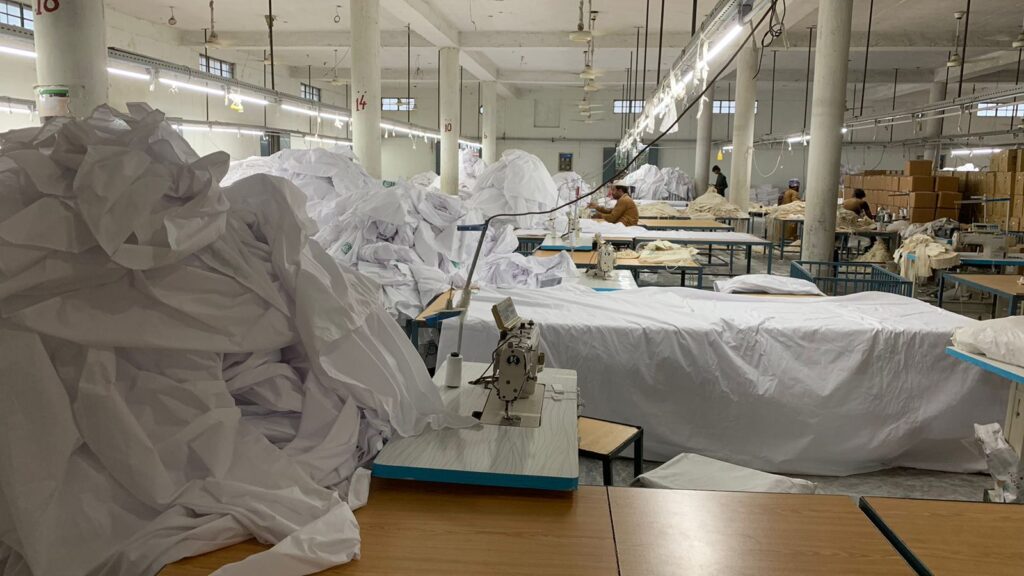
Fabric
There are numerous types of woven fabrics being created. While we produce products based mostly on customer requests and their samples or specifications, certain of our features are standard. We have the ability to process optical white, reactive and vat dyed pigment, as well as pigment and reactive print.
Weave Styles & Qualities:
Plain Fabrics, Sheeting Fabrics, Poplin Fabrics, Oxford, Duck, Herringbone, Twills & Drills, Satins, Sateens, Slub Fabrics, Slub & Polyester Stretch Fabrics, Muslin, Fine Counts up to 400 TC, Panama Fabrics etc.
Running Qualities are:
We manufacture all types of woven grey, dyed, printed textiles used for home linens, sheeting, upholstery, kitchen wear, table linens, hospitals, hotels, clothing, factory wears, etc. in 100 percent cotton, poly-cotton blends, and 100 percent polyester. On power, auto, sulzer, and air jet looms, the maximum grey width is 140″ and the finished width is 126″.
The easiest part is choosing the size and color or design you need – but there are plenty of other decisions to make. When searching for your ideal bed linen you’ll find a whole host of fabrics, weights, thread counts and finishes to choose from – look through our guide to find out which options are right for you.
Fabric
There’s a huge number of different fabrics to choose from when shopping for bed linen, and it’s important to choose the right one for your needs. Some fabrics will keep you warm while others will keep you cool, and every choice will have a different feel against the skin too. Here are some of the fabrics that are most used.
30x 30 / 76x 56
30x 30 / 76x 68
30x 30 / 76x 44
30x 30 / 76x 48
30x 30 / 76x 52
30x 30 / 76x 54
30x 30 / 76x 56
Cotton
The most used choice for bed linen, thanks to its affordability, durability, ease of washing and breathability. There are different types of cotton to choose from too: Egyptian cotton has extra-long fibers making it the highest quality and super-smooth, while Pima cotton is also known for being incredibly soft. Supima® is a branded type of Pima cotton.
16x 16 / 60x 60
20x 20 / 60x 60
20x 16 / 60x 60
24x 24 / 60x 60
Tencel®
This branded fabric is often considered to be more environmentally friendly than cotton, as it uses fewer natural resources to produce. Crafted from wood pulp from the eucalyptus tree, it may be less breathable than cotton, but it’s incredibly durable, very soft and has natural anti-microbial properties.
Polyester
This manmade fabric can be quite scratchy when used on its own, so you’ll often find it combined with other fabrics, such as cotton. It’s an affordable choice, and while cotton is far more breathable, polyester resists stains well and is durable, which is why you’ll often find it used for inexpensive children’s bedding.
16x 16 / 60x 60
20x 20 / 60x 60
21x 21 / 60x 60
22x 22 / 60x 60
22x 25 / 60x 60
24x 24 / 60x 60
30x 30 / 68x 68
Flannel
Flannel is simply cotton that has been combed, making its fibers softer and more fluffy. It’s an incredibly warm fabric, which is why it’s used to create bedding sets that are designed for use in the winter months.
20x 10 / 40x 42
20x 10 / 42x 44
24x 10 / 40x 36
Bamboo
It’s rare to find pure bamboo sheets, as the material can be quite rough and stiff – not what you want from your bedding. Instead, it’s often put through processes that transform it into rayon, which is breathable and durable and has a soft and silky feel.
Silk
Silk is generally associated with luxury, and it’s easy to see why. It’s a fabric that’s hypoallergenic by nature and is lovely and cool – and its smooth and sensuous feel is one of its big selling points. It’s expensive, though, and requires careful laundering.
Blended fabrics
Cotton/polyester, cotton/bamboo, cotton/rayon – there are various blended fabrics out there, but they almost all contain cotton. Generally, they are affordable, crease-resistant, and designed to last, so are often used in children’s bedding.
Weight
The weight of your bed linen may not be something you have considered before but can have a big impact on the quality of your sleep. Weight can be determined by the type of fabric you choose, but also by the way in which the bed linen is made.
Thread count
The term ‘thread count’ refers to the number of threads in each square inch of your bed linen. The higher the thread count, the more closely woven the fabric – and the smoother, softer and more luxurious your bedding will feel. A higher thread count will generally also mean that your bed linen will retain its quality for longer, and it may even get softer over time too. A high thread count is generally anywhere between 200 and 800.
Finish
Fabric, weight, and thread count all have an impact on how your bed linen will feel, how long it will last and how easy it is to care for. But there’s one more element to take into consideration, and that’s the finish. The finish you choose will impact on the color, the texture and the style of your bedding, ensuring you can find something that’s the perfect fit for your bedroom.
Jacquard
A loom-woven fabric with an intricate pattern that is weaved directly into the fabric – it can often be more durable than other woven fabrics too. Jacquard can be made from a variety of different natural and manmade fibers.
Waffle
As the name suggests, the weave of this fabric creates a design of squares that resemble waffles. Waffle fabric tends to be soft and smooth to the touch.
Printed
Designs, pictures, or patterns are printed straight onto the fabric.
Seersucker
A lightweight fabric that is woven in such a way that it is stripy. The stripes alternate between smooth and more textured material, and in places, it can have a natural wrinkled look and feel.
Sateen
Sateen finishes can often be found in bedding as a more affordable alternative to silk. Sateen fabrics are woven in such a way that the top is silky smooth, while the underside remains plain.
